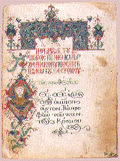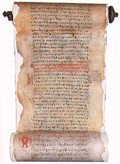 |
| Pict. 72. First page of the liturgy of Saint John Chrysostom. Illustrated manuscript, 17th-18th century. |
 |
| Pict. 73. Saint John Chrysostom. Illustrated manuscript, 17th-18th century. |
 |
| Pict. 74. Parchment manuscript scroll, 12th century. |
|
ln the fourth and last room of the Museum, a small octagon with walled-in showcases, which leads to the end of the
eastern wall of Room 2, objects made of parchment and paper are kept. Manuscripts, with or without miniatures,
documents, books that the Monastery published occasionally, drawings on paper and seals fill this small room.
One of the oldest items is a two-way (boustrophedon) written parchment manuscript roll 4.10 m. long containing the
Holy Liturgy and belonging to circa the 12th century, a time at which the Monastery of the Virgin of Kykkos was
founded (picture 74).
Another official patriarchal document (copy) of 1760 came from Ecumenical Patriarch Serapheim (1757-1761) and
bears the signature of the Synod of the Ecumenical See as well as that of the Archbishop of Cyprus Paisios (1759-1767)
and confirms the stavropegiac status of the Monastery of Kykkos, i.e., its autonomy and independence as far as its
administration is concerned.
Another aspect of the artistic endeavour of the Monastery can be seen in the paper pictures and icons, engravings of
religious themes, which the Monastery used to print and distribute to the faithful during the time of the Turkish rule. Such
pictures were also used to illustrate various publications. Of special note here is a large colour-coated copper-engraving
(picture 71) which was printed in Venice in 1778 and depicts in the middle the Almsgiving Virgin of Kykkos and all round,
in fifteen panels, scenes from the history of the Holy Icon and of the Monastery of Kykkos.
|





